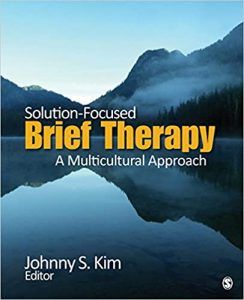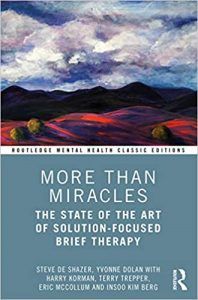How to Use the Miracle Question in Therapy: 3 Examples
 Is the miracle question as good as it sounds? Well, possibly.
Is the miracle question as good as it sounds? Well, possibly.
For the therapist, the intervention has the power to explore clients’ hidden resources and find solutions to their existing problems (Yu, 2019).
The miracle question opens the door to the client’s possibilities for therapy. It does this by simply asking them to consider what an alternate reality might look like – one in which things are different, better, and problems are resolved (Strong & Pyle, 2009).
This article explores the miracle question and how to use it in Solution-Focused Therapy with individuals and groups.
Before you continue, we thought you might like to download our three Goal Achievement Exercises for free. These detailed, science-based exercises will help you or your clients create actionable goals and master techniques to create lasting behavior change.
This Article Contains:
- What Is the Miracle Question in Solution-Focused Therapy?
- The Purpose of the Miracle Question in Therapy
- 3 Examples of the Miracle Question in Action
- 2 Worksheets & Exercises for Your Counseling Sessions
- How to Use the Question in Groups: 2 Activities
- 2 Other Helpful Psychology Techniques
- 3 Fascinating Books on the Topic
- Resources From PositivePsychology.com
- A Take-Home Message
- References
What Is the Miracle Question in Solution-Focused Therapy?
The miracle question is a popular intervention in Solution-Focused Therapy. It asks the client to imagine and discuss a possible world where problems are removed and issues addressed (Strong & Pyle, 2009).
The question may take various forms, such as asking the client, “Assume your problem has been solved. What is different?” Or, “Assume your problem is gone. What does this mean to you?” (Strong & Pyle, 2009, p. 334).
For the therapist, the intervention can “build a good storyline and lead the client to envision how different their life would be if a miracle happened overnight” (Yu, 2019, p. 1930).
The answers provided offer insights to the client while supporting the overall definition of the goals for therapy.
Asking and answering the question involves “proposing and negotiating language that satisfies both therapist and client,” intending to achieve a meaningful understanding of their needs and hopes (Strong & Pyle, 2009, p. 329).
The miracle question and Solution-Focused Therapy (SFT)
The focus of SFT is on “what is preferred and helpful to clients in attaining their goals” (Strong & Pyle, 2009, p. 332). Clients typically find SFT a helpful approach in which the therapeutic dialogue works to construct the therapeutic outcomes.
The miracle question prompts and motivates negotiation between therapist and client. When introduced into the session, it typically offers a departure from the prior dialogue. The conversation then proceeds to work out the full meaning of the answer given (Strong & Pyle, 2009).
The therapist must tailor the question according to the client’s experiences, language, and understanding to ensure it is appropriately understood, considered, and answered. After all, it is a big question that may not be easy to answer; it invites the client to reflect on broader issues and engage in what-if thinking.
The power of the miracle question is to bring clarity to the therapeutic process while strengthening the therapeutic alliance through the client’s presentation of their problem (Strong & Pyle, 2009).
The Purpose of the Miracle Question in Therapy

The therapist uses the insight it provides to “bring forth clients’ ideas, goals, and possibilities” to uncover the potential outcomes of therapy (Strong & Pyle, 2009, p. 347).
When the client considers the question, it generates new dialogue with the therapist with the miracle as a clear focus. Whether a starting point or later in the interview, it introduces (or reintroduces) further potential for growth into the conversation (Strong & Pyle, 2009).
The client becomes more active and potentially more engaged in the therapeutic process, constructing and negotiating valuable meanings and insights while showing that they wish to benefit from the discussion.
The power of the miracle question appears to be in its ability to lift clients out of ‘real life,’ shaking loose their constraints and imagining what could be. Crucially, it helps the client piece together a specific and elaborate vision of what their lives would be like in the absence of a problem. Along with setting goals, the purpose of the miracle question is to (Stith et al., 2010):
- Generate a virtual vision of what life would be like if a miracle occurred.
- Prepare the client for exceptions to the problem, glimpsing a world in which the problem is no longer present, either temporarily or permanently.
- Create a progressive narrative where the client’s life is pictured as becoming better rather than worse.
For the therapist and client, the response to the miracle question becomes “the common ground upon which the two agree to build a new foundation” (Stith et al., 2010).
3 Examples of the Miracle Question in Action
The following three examples explore how to use the miracle question and its impact.
Asking the miracle question
You can modify the following approach and wording according to the circumstances, such as individual, couple, or family therapy (modified from Yu, 2019).
Try out the following with your clients:
This may seem like a strange question to ask, but please bear with me. Imagine going about your life as normal and heading off to sleep at the usual time.
Unknown to you, during the night, something happens – a miracle. When you wake up the following day, something exciting has happened.
The very problem that brought you to see me today is no longer there.
What would be the very first difference you would notice in your life?
Helpful follow-ups
The following questions offer valuable follow-ups and progress the dialogue. They help the client create and explore new possibilities (modified from Yu, 2019, p. 1931):
- How will you know the miracle has happened?
- What will others (parents, partner, children, work colleagues, etc.) notice about you that makes them aware things are different or better?
- What would their reaction be? What would they do?
- What would you do next?
- What would we see (feelings, thoughts, and behavior) if we compared a before and after picture?
- Have you ever seen elements of this happen before?
Answering the miracle question
The following statements are two unique examples of responses to the miracle question given by a couple during marriage therapy, having sought help for relationship difficulties (Yu, 2019, p. 1931):
- “We would spend more time with each other like we used to.”
- “My wife would have an interest in me again like when we first started dating.”
Language becomes more than a tool for understanding. The process of asking, sharing, and understanding the miracle question communicates experiences and wishes between the speaker and the listener (Strong & Pyle, 2009).
It is important to remember that while initiated as a single question, the broader process of creating a vision of what life could be like may require an entire session. Furthermore, it takes skill to pose follow-up questions, yet it is worthwhile, as it involves building more detail and meaning through elaboration (Stith et al., 2010).
2 Worksheets & Exercises for Your Counseling Sessions

As this deviation from reality can seem like strange and unfamiliar territory, the following activities may help.
Dare Question worksheet
Sometimes, we don’t know what we really want. As a result, answering the miracle question may not be easy.
The Dare Question worksheet uses a slightly different approach. Rather than asking what it would be like “if you woke up tomorrow and the problem had disappeared,” it asks, “What would you do if you knew you could not fail?”
Have you ever truly taken time to consider what you want out of life? Most of us haven’t thought about what it might look like, how it would feel, and how we would behave and appear to others.
Revisit this exercise regularly. Become comfortable with the idea that you are imagining what you would do if you couldn’t fail. Letting go of self-doubt may take some time.
Use the answers to plan how you might set about achieving such goals.
Should Question worksheet
It is essential to understand the reasons behind what we do and don’t do. Our beliefs and thoughts shape our current decision-making, behavior, and potential to choose the life we could lead.
Use the Should Question worksheet to consider what we do, why, and says who?
The answers will reveal the beliefs you have about yourself that may be limiting your present or miracle question behavior.
Use it to create a new set of affirmations that can turn the answers to your miracle question into reality. These points target the things in your life that require focus.
The miracle question: used by psychologists
How to Use the Question in Groups: 2 Activities
Learning to use the miracle question positively in groups to generate conversation and progress requires a little more thought. It becomes even more critical to phrase the question well, create goals, engage, find exceptions to the problems, remain patient, and respond to each client in the group constructively (Stith et al., 2010).
The miracle question can be helpful with survivors of natural disasters, including children as young as six. Working in families or larger groups, the process “can facilitate adaptive coping, immediate solution-building,” and provide an opportunity to share essential strategies to discuss emotions, fears, and needs (Steinbrecher, Jordan, & Turns, 2020, p. 13).
Group miracle question
The miracle question is powerful in a group setting. The process helps to imagine how good life could be if the group had everything they ever wanted.
- Ask the group to sit in a circle and close their eyes.
- Ask them to picture the following:
Imagine waking up tomorrow morning. By some miracle overnight, you have been given everything you ever wanted and life has turned out just as you have always wished.
- Ask each member of the group to keep imagining and ask themselves the following:
What would you notice that would make you realize the miracle had happened?
What would you hear and see?
How would you feel differently inside?
How would you be different?
- Ask the group to share how that future might look and feel.
- Then ask them to share what steps they could take to make some of this come true.
Group miracle question exercise
While the following exercise is powerful for individuals, it can promote intense discussion and valuable sharing of solutions in a group.
- Ask the group to sit in a circle and close their eyes.
- Ask them to picture the following:
Imagine waking up tomorrow morning. By some miracle overnight, all your problems are gone.
- Ask the group to imagine how they would feel and behave.
- Ask the group to choose one thing (it can be very small) they might do if the miracle happened, such as meeting with friends, beginning a new class, or starting to exercise.
- Now, imagine acting as if the problem were gone. How could you progress with your new activity, action, or behavior if your problem were no longer there?
- Ask the group to share the one thing they would start doing if their miracle happened; encourage them to explore how it would feel trying out the new behavior.
2 Other Helpful Psychology Techniques

Exception questions
It can be helpful to reflect upon exceptions to the present problems in the client’s life. Such an approach can be a valuable way to “discover clients’ previous successes and amplify the client’s strengths” (Yu, 2019, p. 968).
While the miracle question offers insight into treatment goals, exception questions highlight possible pathways to achieve them (Yu, 2019).
An example exception question and statement include:
- Was there a time when you were able to respond without anger?
- Tell me of a time when you and your wife enjoyed one another’s company.
Scaling questions
Scaling questions provide a useful way to assess a client’s progress toward their goals. “The evaluation outcome can further guide the treatment by adjusting the behavior modification plan” in therapy (Yu, 2019, p. 2560).
Such questions are popular in Solution-Focused Brief Therapy, where the aim is to find immediate solutions and actively assist clients in resolving their problems.
Two examples of scaling questions include:
- On a scale of 0 to 10, how committed are you to finding a solution to your relationship problems?
- On a scale of 0 to 10, how controlled do you feel by your father?
3 Fascinating Books on the Topic
Many therapy books focus on the power of therapy and how using the right interventions can strengthen the therapeutic alliance and increase the chances of a positive outcome.
We have chosen three of our favorites below.
1. Solution-Focused Brief Therapy with Clients Managing Trauma – Adam Froerer, Jacqui von Cziffra-Bergs, Johnny Kim, and Elliott Connie
This fascinating book introduces Solution-Focused Brief Therapy (SFBT) and its use with clients facing trauma.
This evidence-based text offers advice from experienced practitioners and academics on providing clients with a powerful future and taking the path toward healing and health.
Find the book on Amazon.
2. Solution-Focused Brief Therapy: A Multicultural Approach – Johnny Kim
Johnny Kim provides valuable insights into the essence of SFBT, its implications, and crucial considerations from a multicultural perspective.
Interventions are described and explored, along with case examples and supporting research.
Find the book on Amazon.
3. More Than Miracles – Steve de Shazer et al.
Steve de Shazer was an early pioneer in the field of SFBT and world-renowned family therapist.
This second edition of his book includes the latest developments in the field, real-life case studies, and supporting guidance and interventions.
Find the book on Amazon.
Resources From PositivePsychology.com
We have many worksheets, tools, and interventions that can help clients (individually or in couples) address underlying issues and identify and work toward their goals:
- Your Miracle Worksheet
This worksheet can be used to capture a client’s answer to the miracle question, evaluate their support network, and consider next steps for action. - Marital Conflicts Questionnaire
This questionnaire can be used alongside the miracle question to understand what is causing conflict in a relationship. - Imagining Solutions to Social Problems
This worksheet invites clients to generate many possible solutions to a current interpersonal problem and imagine how applying solutions to that problem might look. - Reflective Questions in Therapy
This worksheet presents a list of 18 questions therapists can ask clients to facilitate insights around goals, thinking, and behavior.
If you’re looking for more science-based ways to help others reach their goals, check out this collection of 17 validated motivation and goal achievement tools for practitioners. Use them to help others turn their dreams into reality by applying the latest science-based behavioral change techniques.
A Take-Home Message
The miracle question appears surprisingly straightforward, yet it has the power to provide deep insights into the client’s goals, wishes, dreams, and the obstacles they put in their way.
The potential of the miracle question comes from its ability to create understanding and the awareness it generates through ongoing dialogue. Such questions talk new and additional meaning into being and help shape the therapeutic outcome (Strong & Pyle, 2009).
Research into asking and answering the miracle question shows it creates dialogue through negotiation. The meaning is constructed between client and therapist socially, while they responsively negotiate what they say and how they say it (Strong & Pyle, 2009).
The answer to the question – what the miracle looks like – is woven back into the client’s life and their network of interpersonal relationships (Stith et al., 2010).
The miracle question is incredibly valuable for the client and the therapeutic process; indeed, “when therapists are taught that the miracle question is a tool for creating hope, their faith in their clients will increase, and their anxiety will decrease as a result” (Stith et al., 2010).
Therapists can adopt the miracle question as a powerful tool for encouraging further conversation and uncovering the deeper drives that brought the client to their office for help.
We hope you enjoyed reading this article. Don’t forget to download our three Goal Achievement Exercises for free.
- de Shazer, S., Dolan, Y., Korman, H., Trepper, T., McCollum, E., & Berg, I. K. (2021). More than miracles (2nd ed.). Routledge.
- Froerer, A. S., von Cziffra-Bergs, J., Kim, J. S., & Connie, E. E. (Eds.). (2018). Solution-focused brief therapy with clients managing trauma. Oxford University Press.
- Kim, J. S. (Ed.). (2013). Solution-focused brief therapy: A multicultural approach. Sage.
- Steinbrecher, E., Jordan, S. S., & Turns, B. (2020). Providing immediate hope to survivors of natural disasters: A miracle question intervention. The American Journal of Family Therapy, 49(2), 204–219.
- Stith, S. M. , Miller, M. S., Boyle, J., Swinton, J., Ratcliffe, G., & McCollum, E. (2010). Making a difference in making miracles: Common roadblocks to miracle question effectiveness. Journal of Marital and Family Therapy, 38(2), 380–393.
- Strong, T., & Pyle, N. R. (2009). Constructing a conversational “miracle”: Examining the “miracle question” as it is used in therapeutic dialogue. Journal of Constructivist Psychology, 22(4), 328–353.
- Yu, F. (2019). Miracle question in couple and family therapy. In J. L. Lebow, A. L. Chambers, & D. C. Breunlin (Eds.), Encyclopedia of couple and family therapy. Springer.
Let us know your thoughts
Read other articles by their category
- Body & Brain (49)
- Coaching & Application (57)
- Compassion (26)
- Counseling (51)
- Emotional Intelligence (24)
- Gratitude (18)
- Grief & Bereavement (21)
- Happiness & SWB (40)
- Meaning & Values (26)
- Meditation (20)
- Mindfulness (45)
- Motivation & Goals (45)
- Optimism & Mindset (34)
- Positive CBT (29)
- Positive Communication (20)
- Positive Education (47)
- Positive Emotions (32)
- Positive Leadership (18)
- Positive Parenting (4)
- Positive Psychology (33)
- Positive Workplace (37)
- Productivity (17)
- Relationships (46)
- Resilience & Coping (36)
- Self Awareness (21)
- Self Esteem (38)
- Strengths & Virtues (32)
- Stress & Burnout Prevention (34)
- Theory & Books (46)
- Therapy Exercises (37)
- Types of Therapy (64)








What our readers think
I use this but had gotten away from it, thanks for the info in one place